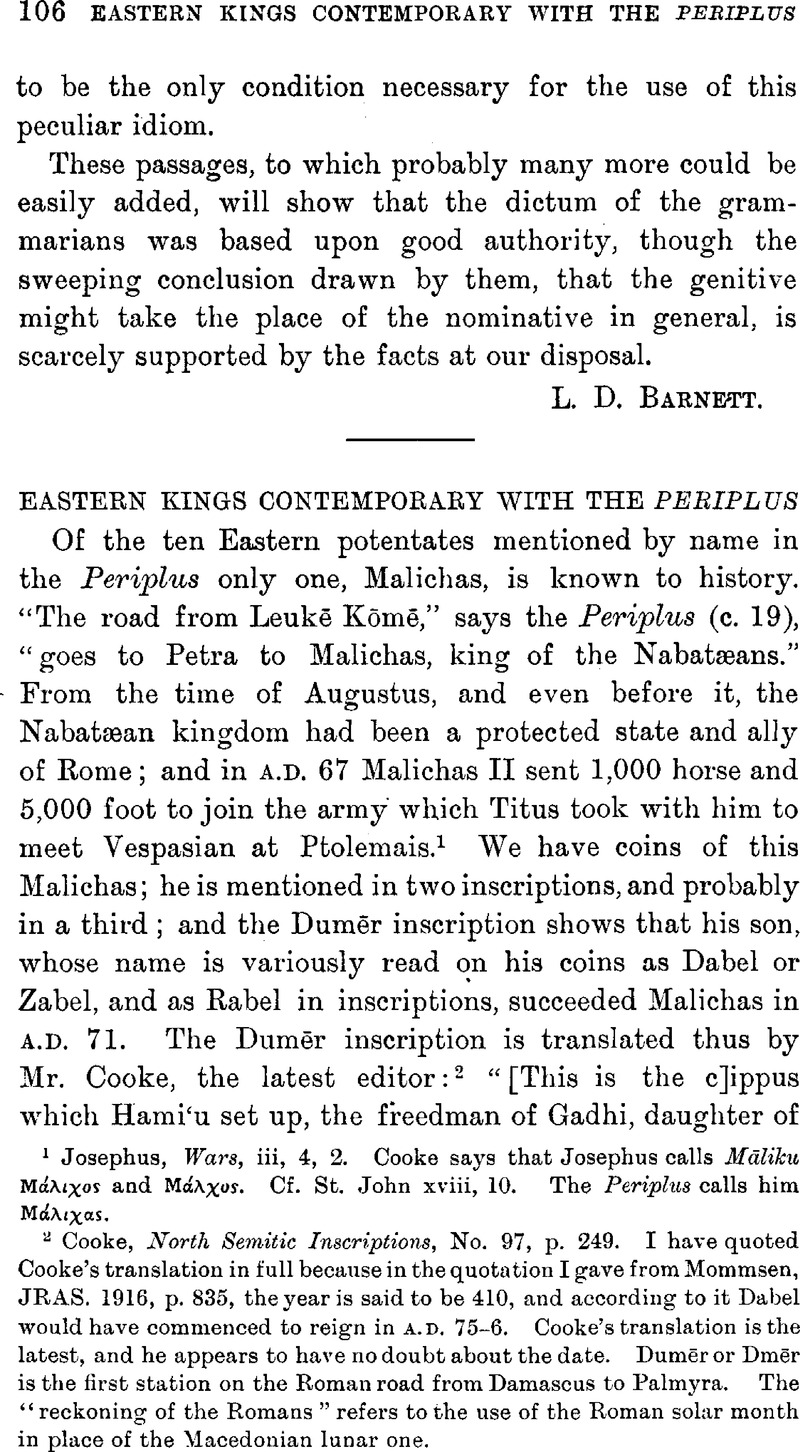No CrossRef data available.
Published online by Cambridge University Press: 15 March 2011

page 106 note 1 Josephus, , Wars, iii, 4, 2Google Scholar. Cooke says that Josephus calls Māliku Μλιχος and Μλχος. Cf. St. John xviii, 10. The Periplus calls him Μλιχος.
page 106 note 2 Cooke, , North Semitic Inscriptions, No. 97, p. 249Google Scholar. I have quoted Cooke's translation in full because in the quotation I gave from Mommsen, JRAS. 1916, p. 835Google Scholar, the year is said to be 410, and according to it Dabel would have commenced to reign in A.D. 75–6. Cooke's translation is the latest, and he appears to have no doubt about the date. Dumēr or Dmēr is the first station on the Roman road from Damascus to Palmyra. The “reckoning of the Romans” refers to the use of the Roman solar month in place of the Macedonian lunar one.
page 107 note 1 Ibid., No. 101, p. 255.
page 107 note 2 Κατ δ τν αὐτν το![]() τον χρνον κα Πλμας τ
τον χρνον κα Πλμας τ![]() ς Συρας
ς Συρας ![]() ρχων τν 'Αραβαν τν πρς τ
ρχων τν 'Αραβαν τν πρς τ![]() Πτρᾳ χειρώσατο κα Ρωμαων ὑπκοον ποισατο (Dio Cass., lxviii, 14, 5). We know none of the details. The event is commemorated in the era of Bostra, which now became the capital, and Trajan's milestones are still found in situ along the great Roman road which he constructed from Damascus to the head of the Ælanitic Gulf.
Πτρᾳ χειρώσατο κα Ρωμαων ὑπκοον ποισατο (Dio Cass., lxviii, 14, 5). We know none of the details. The event is commemorated in the era of Bostra, which now became the capital, and Trajan's milestones are still found in situ along the great Roman road which he constructed from Damascus to the head of the Ælanitic Gulf.
page 107 note 3 “It is regarded as probable that Prideaux is right in his identification of the Karib'il Watar Yehun'im, who struck coins at Raidan, with the Karib'il Watar Yehun'im, king of Saba and Eaidan, known from a number of inscriptions, and with the χαριβαλ, who was reigning at the time when the Periplus Maria Erythræi was written, that is, about A.D. 70. But since there were three rulers called Karib'il, it must be admitted that the last-named equation of the Charibael of the Periplus with the king who struck the coins is open to dispute” (Hill, G. F., The Ancient Coinage of Southern Arabia, p. 13Google Scholar). Several Hadhramaut kings bore the name of Ili-azzu according to Glaser, but they have left no coins, and their dates are still unknown.
page 107 note 4 Tyrannos in the Periplus (and also in Strabo) denotes a petty local chief, usually a vassal like Cholaebos. JRAS. 1913, p. 125.Google Scholar
page 108 note 1 Cf. JRAS. 1916, pp. 836–7.Google Scholar
page 109 note 1 Nahapāna issued a great number of coins; it is therefore inferred that his reign was long. He is mentioned in inscriptions dated 41, 42, 45, and 46, of an era which is generally taken to be the Saka era. These years correspond to A.D. 119, 120, 123, and 124; and from other inscriptions it would follow that he died soon after. But Mr. Rakhaldas Banerji disputes the attribution of the years to the Saka era (JRAS. 1917, pp. 273 ff.Google Scholar), and places him at the commencement of the Christian era. Accepting, however, the era as the Saka era, the date of Nahapāna's accession to the throne is quite uncertain. Mr. V. Smith puts it between A.D. 60 and 90.
page 109 note 2 Authorized emporium = μπριον ![]() νθεσμον. A more usual expression in the Periplus is μπριον νμιμον. It means a place where authorized tolls and market dues were levied. Foreigners had to pay for permission to trade; they were therefore limited to certain places; and the dues were levied, according to the immemorial custom of the East, partly in the markets, but more generally at the houses where the foreigners put up. Adule, Mouza, and Apologos, at the head of the Persian Gulf, were such authorized trading centres according to the Periplus.
νθεσμον. A more usual expression in the Periplus is μπριον νμιμον. It means a place where authorized tolls and market dues were levied. Foreigners had to pay for permission to trade; they were therefore limited to certain places; and the dues were levied, according to the immemorial custom of the East, partly in the markets, but more generally at the houses where the foreigners put up. Adule, Mouza, and Apologos, at the head of the Persian Gulf, were such authorized trading centres according to the Periplus.
page 109 note 3 Rapson, , Indian Coins (Grundriss), p. 15Google Scholar, para. 61. Sallet puts him after A.D. 77.
page 110 note 1 Smith, V., Early History, etc., table, p. 202 (2nd ed.). On p. 194Google Scholar, speaking of this table Mr. Smith says: “The intermediate dates inserted in the chronological table at the end of this chapter are merely rough approximations to the truth, being based upon the lengths of reigns as stated in the Purānas, which are known to be untrustworthy.”
page 110 note 2 JRAS. 1917, p. 482Google Scholar, n. 1, where the matter is more fully discussed.
page 111 note 1 Cf. Periplus, c. 41 and c. 48.
page 111 note 2 JRAS. 1916, pp. 835–6.Google Scholar
page 112 note 1 JRAS. 1917, pp. 827 ff.Google Scholar
page 112 note 2 Schoff, , The Periplus of the Erythræan Sea, pp. 14–15.Google Scholar
page 112 note 3 JRAS. 1917, p. 830.Google Scholar
page 113 note 1 JRAS. 1916, p. 829.Google Scholar